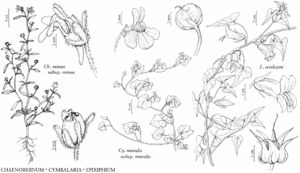Cymbalaria
Brit. Herb., 113, plate 17 [upper left center]. 1756.
| Taxon | Illustrator ⠉ | |
|---|---|---|
 | Chaenorhinum minus subsp. minus Cymbalaria muralis subsp. muralis Epixiphium wislizeni | Yevonn Wilson-Ramsey Barbara Alongi Barbara Alongi |
Herbs, perennial. Stems pendent or prostrate, glabrous [villous]. Leaves cauline, alternate [opposite]; petiole present; blade reniform to orbiculate, fleshy, not leathery, margins lobed [entire]. Inflorescences axillary, flowers solitary; bracts absent. Pedicels present, often elongating in fruit; bracteoles absent. Flowers bisexual; sepals 5, basally connate, calyx radially symmetric, campanulate, lobes linear to lanceolate, glabrous; corolla lilac to violet [blue, white], bilaterally symmetric, bilabiate and personate, tubular, tube base not gibbous, spurred abaxially, lobes 5, abaxial 3, adaxial 2; stamens 4, basally adnate to corolla, didynamous, filaments glabrous; staminode 0; ovary 2-locular, placentation axile; stigma scarcely clavate, entire. Fruits capsules, dehiscence loculicidal [indehiscent]. Seeds [6–] 15–40, dark-brown to black, ovoid to oblong, wings absent. x = 7.
Distribution
Introduced; Europe (Mediterranean region), sw Asia, in Mexico, Central America, South America, Asia, Africa, Atlantic Islands, Pacific Islands, Australia
Discussion
Species 9 (1 in the flora).
Cymbalaria is characterized by personate, spurred corollas and lobed, reniform to orbiculate leaf blades with palmate venation. Generic delimitation has been consistent since R. Wettstein (1891–1893) treated Cymbalaria as distinct from Linaria. Cymbalaria muralis has been included in molecular phylogenetic analyses of Antirrhineae and Plantaginaceae. Using multiple plastid and nuclear molecular markers, Cymbalaria is strongly supported as a monophyletic clade sister to Asarina procumbens Miller (M. Ghebrehiwet et al. 2000; D. C. Albach et al. 2005; M. Fernández-Mazuecos et al. 2013; P. Carnicero et al. 2017). Several investigations support sister group status for Asarina Miller and Cymbalaria and the New World Maurandyinae clade represented by Epixiphium, Lophospermum D. Don, Maurandya Ortega, Maurandella, and Rhodochiton Zuccarini ex Otto & A. Dietrich.
Selected References
None.
Lower Taxa
"elongating" is not a number.